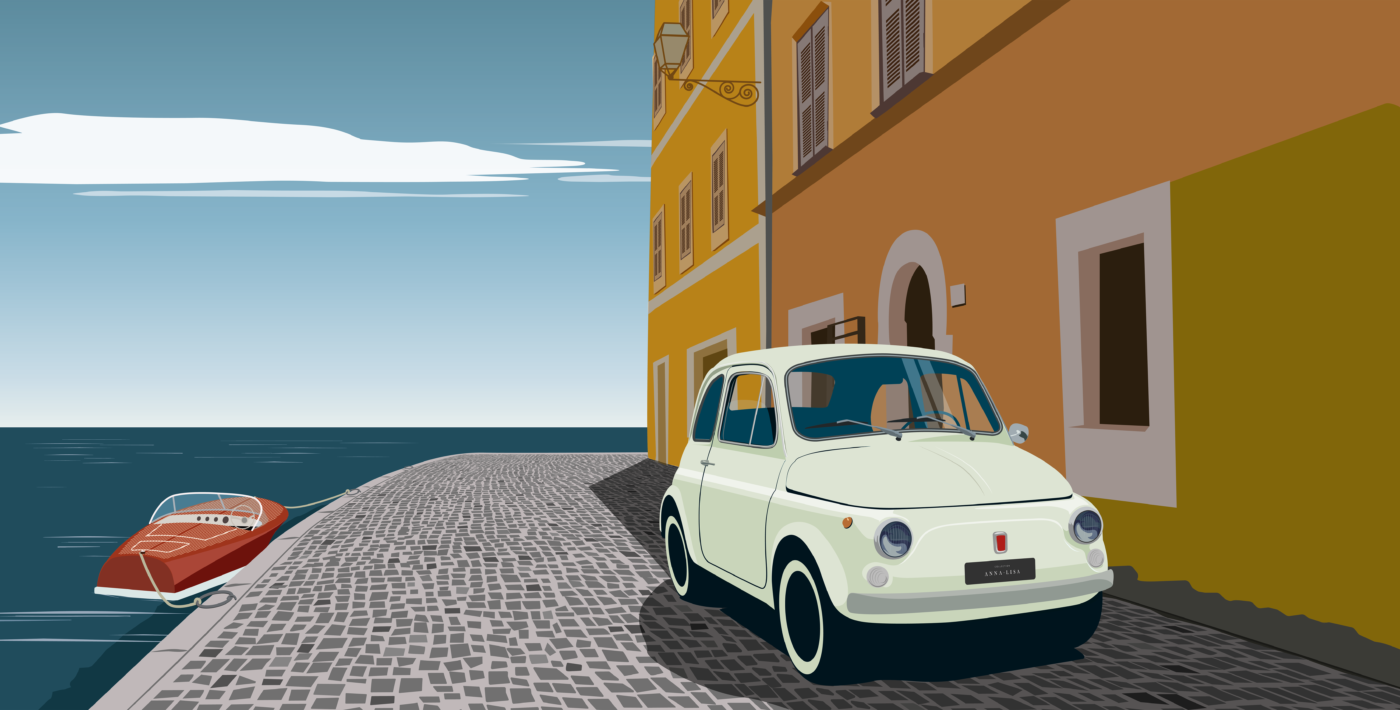
Fiat
If one were to associate Italy with a brand, there is no doubt that FIAT would be in the top 5, certainly alongside Ferrari, Buitoni and Ferragamo. It must be said that the “ Fabbrica Italiana Automobili Torino ”, born in 1899, has accompanied, and even more so symbolised, the greatest hours of Italian history.
As early as 1900, Fiat was not stingy with its ambitions, creating a 12,000 m2 factory in Turin, able to produce more than a thousand cars by 1906, a large proportion of which were already exported, as far as to the USA. However, this era was still more artisanal than truly industrial.
1916 was a key date for Fiat and beyond for Italy, as it marked the start of the construction of the most modern factory in the world, a monument of design and engineering, the Lingotto factory in Turin. There is no shortage of superlatives to describe this masterpiece, inaugurated in 1923, which has become the symbol of the city of Turin. Years later, the film “The Italian Job” made it one of the stars of the film scenario. This five-storey complex, then the largest factory in the world, displays the best of Taylorism: spare parts are assembled on the ground floor and the cars are assembled floor by floor until they are finished on the top floor before they reach the roof, which houses a test track! This iconic building is a perfect illustration of Fiat’s destiny as a popular and innovative brand with global ambitions. But the Fiat empire is not limited to the production of cars, it is also renowned for its expertise in the manufacture of commercial vehicles, trucks, buses, tractors and even military equipment in times of war.
The ANNA LISA Art On Wheels collection has housed several cars from this key period, including the robust, spacious and affordable Fiat 501. Launched in 1919 at the end of the war, the 501 had one ambition: to compete with the Ford T and establish the brand as the market leader in so-called popular cars. The Fiat 505, also part of the ANNA LISA collection, followed it. It too was a great success, with many variants, including the very elegant green torpedo seen in our collection. Another more imposing and commercially confidential model is part of the collection, the 512 Torpedo, powered by a six-cylinder engine and popular in export markets.
The Fiat name is associated with another dynasty, the Agnelli family. Giovanni Agnelli, nicknamed “il senatore”, ruled the company for 40 years between 1902 and 1942. He was responsible for great industrial and commercial achievements, starting with the launch of the 508 Balilla, a compact car that has been extremely popular. It perfectly embodies the growing democratization of automobile use in Italy. If the ANNA LISA Art On Wheels collection has included a Balilla from 1933, it has also housed a superb Balbo 1500B convertible launched in 1939, which illustrates another Italian reality, that of coachbuilders’ cars.
It was Giovanni’s grandson, Gianni, nicknamed “l’avvocato”, who truly symbolised the company. Gianni Agnelli is in fact the very embodiment of the Italian condotierre, which stand for captains of industry who fascinate the world with their power, charisma, style and infinite wealth. There is even a Gianni Agnelli style that combines a suit worn with mountain boots, a watch worn on the sleeve of a shirt or custom-made Ferraris. In this respect, the 1966 Fiat 1500 Coupé from the ANNA LISA Art On Wheels collection, with its Pininfarina-signed lines, embodies this Italian elegance of the 1960s.
But beyond its style, Gianni Agnelli was responsible for transforming Fiat into a worldwide empire that absorbed Lancia, Autobianchi, Ferrari, Abarth, Iveco, etc… The group was then an undisputed champion in motor racing, but also in railways industries airlines, and agriculture. It even bought the newspaper mogul La Stampa… In oyher words, Fiat has always accompanied Italians in their daily lives since the hard working years of the post-war period, when the Fiat 1400 A, of which the ANNA LISA Art On Wheels collection owns a 1955 model, symbolised the popular and serious family car.
The successor to the Topolino, the Fiat 500, was produced in 4,250,000 units between 1957 and 1975, with numerous variants, such as the 500L part of the ANNA LISA Art On Wheels collection, whose garage neighbours are a Topolino and a Fiat 500A.
The end of the 20th and the beginning of the 21st centuries marked a decline of the group, especially for its premium brands, with the clear exception of Ferrari. It was a time of instability for Fiat, which nevertheless resisted numerous crises. Its salvation was due to profound restructuring and the undeniable success of the new Fiat 500, voted car of the year in 2008. Now an integral part of the giant Stellantis, the brand should continue to radiate around the world with its strong Italian identity, which is still the pride of the country.